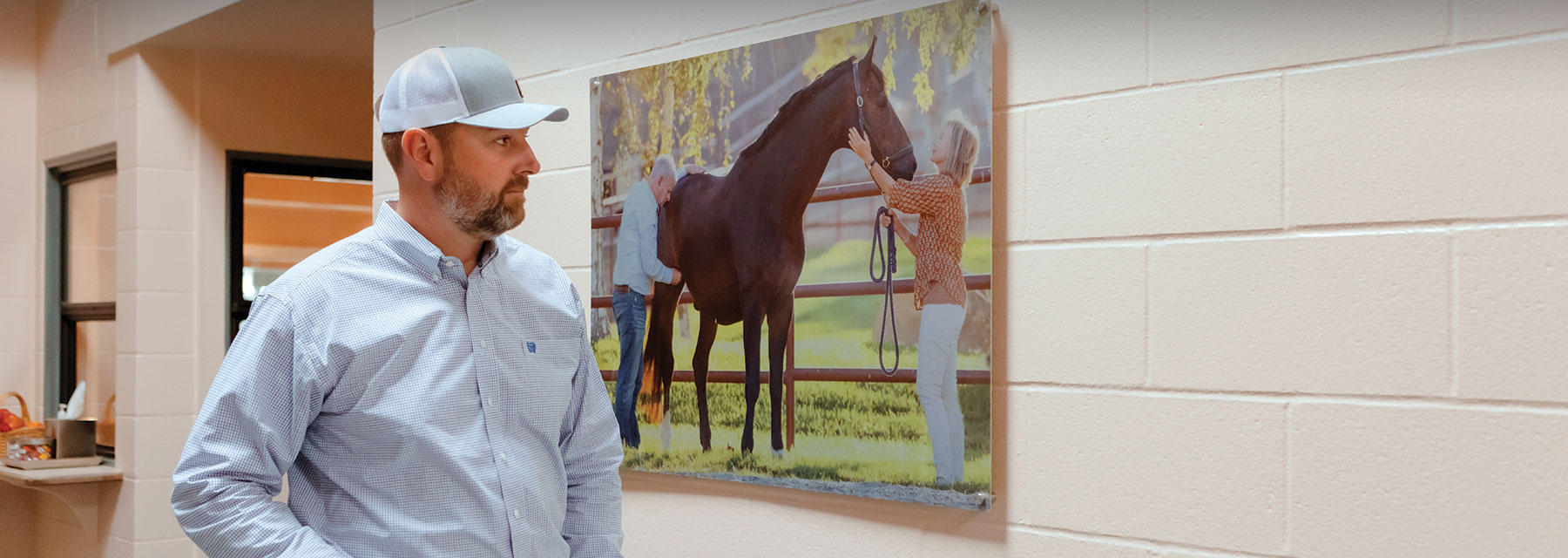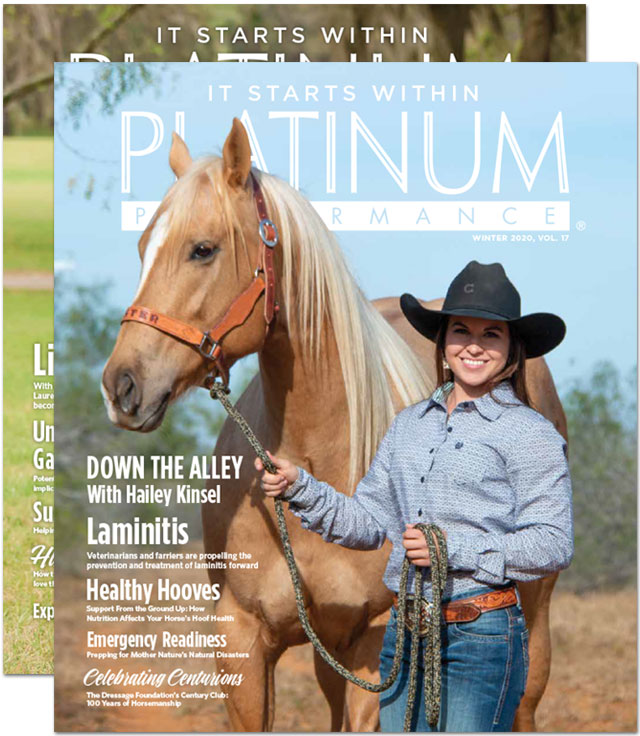Dr. Troy Herthel Follows in the Footsteps of His Legendary Father, Dr. Doug Herthel, While Carving Out His Own Path in Veterinary Medicine at Alamo Pintado Equine Medical Center
Dr. Troy Herthel’s path to veterinary medicine was innate; woven into the fibers of his soul from his earliest days. The son of renowned veterinarian, surgeon and medical innovator Dr. Doug Herthel and his beloved wife, Sue, Troy, their youngest, has managed to meld the reverence for his parents’ legacy with his own passion for veterinary medicine, carrying on the trailblazing spirit of the family’s Alamo Pintado Equine Medical Center together with a boldly-talented team of veterinarians.
This is a tailgate town. The flag flies high above the only four-way stop in the tiny village of Los Olivos, California, a 30-minute drive north of Santa Barbara in the Santa Ynez Valley. People still smile and wave here; they gather for holidays and small-town festivals to celebrate harvest and savor the wine and olive oil cultivated from their own soil. Roots run deep here, where ranching families still work livestock on the same land their ancestors tilled and rode well over 100 years ago. Tractors roll down Grand Avenue and pirate flags flap in the fall breeze on Friday nights as football fans gather under stadium lights to support the high school team. Los Olivos offers charming wine tasting rooms and quaint boutiques next to farm-to-table restaurants and cozy inns, but somehow the quiet hum of life here has always revolved around the horse. They graze on fertile grasses in nearly every field as you drive the backroads. Spurs jangle down sidewalks and breeches and tall boots stroll into the post office until it closes for the day at 3 o’clock. The horse is engrained into life here and infused into the culture of this little town.
This place captured the hearts of Dr. Doug and Sue Herthel some 50 years ago as they set out on what would become a storied adventure. It’s here that they founded Alamo Pintado Equine Medical Center in 1972, a place that has become a beacon of discovery and innovation in equine veterinary medicine and has done so with a spirit of ingenuity, determination and service. The couple raised their family here and assembled a team of exceptional veterinarians. From humble roots, Alamo Pintado Equine became a celebrated local haven just as it enjoys an international reputation at the forefront of technology, research and equine medical progress.
As a boy, Troy watched, listened and absorbed what his father and the medical center’s team of professionals did each day. Call it providence or a genetic predisposition to serve the horse; either way, Troy felt the pull of veterinary medicine from early on. “Growing up inside Alamo Pintado Equine was a childhood that was completely unique. To me it was just normal. That’s all I’ve ever known,” Troy says reflecting. The elder Dr. Herthel was a hero to the horse and a larger-than-life figure in the eyes of so many throughout the industry. Soft spoken and humble but firm in his determination to challenge the impossible, his mindset was always aimed at pursuing a better way to treat, heal and serve his patients and the clients he held in such high regard. No one knew him better, however, or admired him more deeply than his boys, Troy and his older brother, Mark. “My dad always felt a huge commitment to the horse in general,” says Troy. “That was the most important thing to him.” To Troy, his own path forward was destined from the start. Whatever passion for the profession coursed through the elder Dr. Herthel’s veins was passed on to his youngest son in spades.
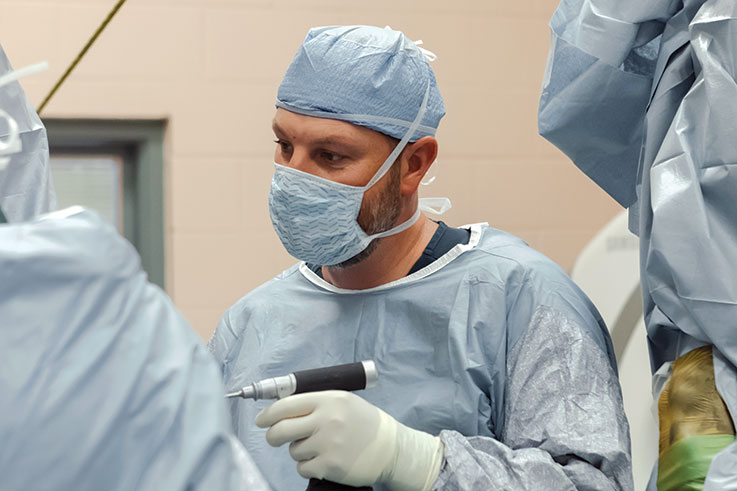
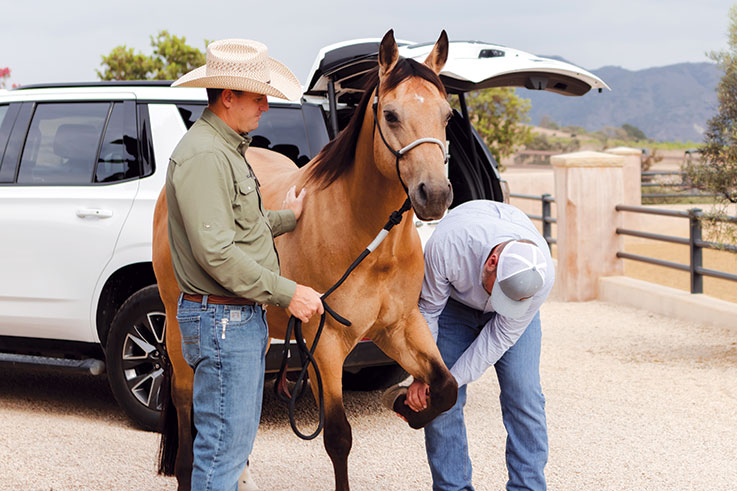
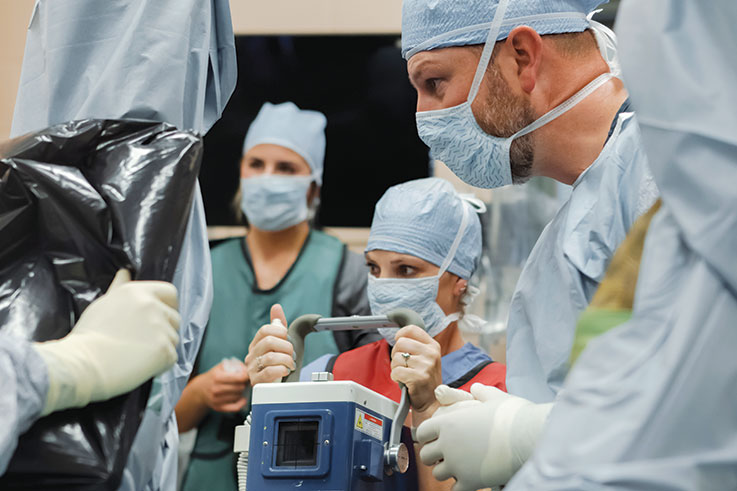
PHOTOS BY ELIZABETH HAY PHOTOGRAPHY
Despite the clinic experience, in many ways Troy was a typical small-town kid. As a teen he donned cleats and pads each fall, proudly wearing a pirate jersey as quarterback of Santa Ynez High’s football team. Win or lose on Friday night, Saturday morning he was at his dad’s side, observing a colic surgery or a lameness exam, or riding in Dr. Herthel’s right seat as they answered a farm call. His early veterinary education also quietly included advice and observations of such Alamo Pintado Equine stalwarts as Drs. Mark Rick, Carter Judy, Ed Hamer and Greg Parks. After high school, Troy studied at Cal Poly, San Luis Obispo, then went on to veterinary school at Oklahoma State University. Always appreciative of his dad’s tutelage, Troy would earn his own way, prove himself and ensure that he would become a veterinarian based on his own merits and not on the coattails of his celebrated last name. Earning his DVM in Stillwater, Oklahoma, the newly minted Dr. Troy Herthel migrated south to Texas where he trained at Weatherford Equine Medical Center under a top-tier team that includes Dr. Jeff Foland, who as a recent veterinary school graduate in the late 1980s, became an intern veterinarian at Alamo Pintado Equine. There was little sleep and a high caseload, two things that the young Dr. Herthel embraced as he cut his teeth. In addition, he reached out to some of the best in the business, including legendary practitioners like Dr. Wayne McIlwraith, a pioneer in equine arthroscopic surgery and regenerative equine orthopaedic research at Colorado State University, Dr. Larry Bramlage, a famed surgeon and lameness guru at Rood & Riddle Equine Hospital in Lexington, Kentucky, and Dr. Cliff Honnas, a tenured Texas A&M University veterinary professor for 19 years, who opened Texas Equine Hospital in Bryan, Texas in 2009.
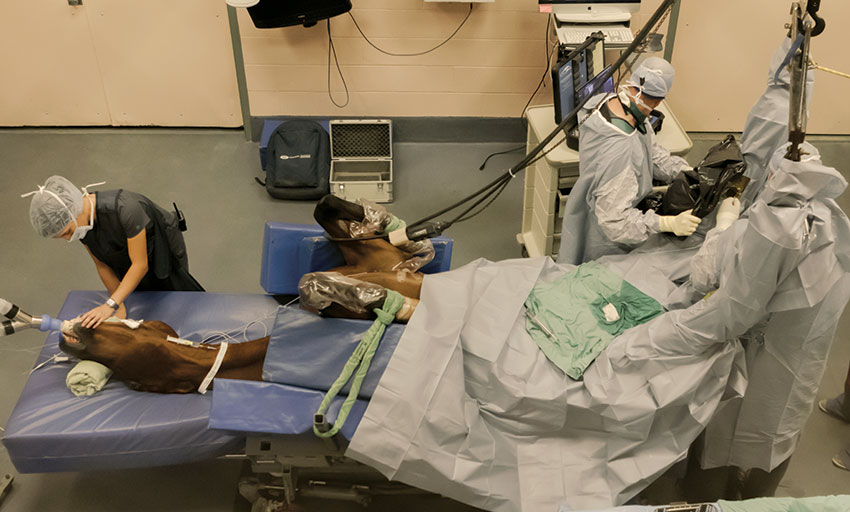
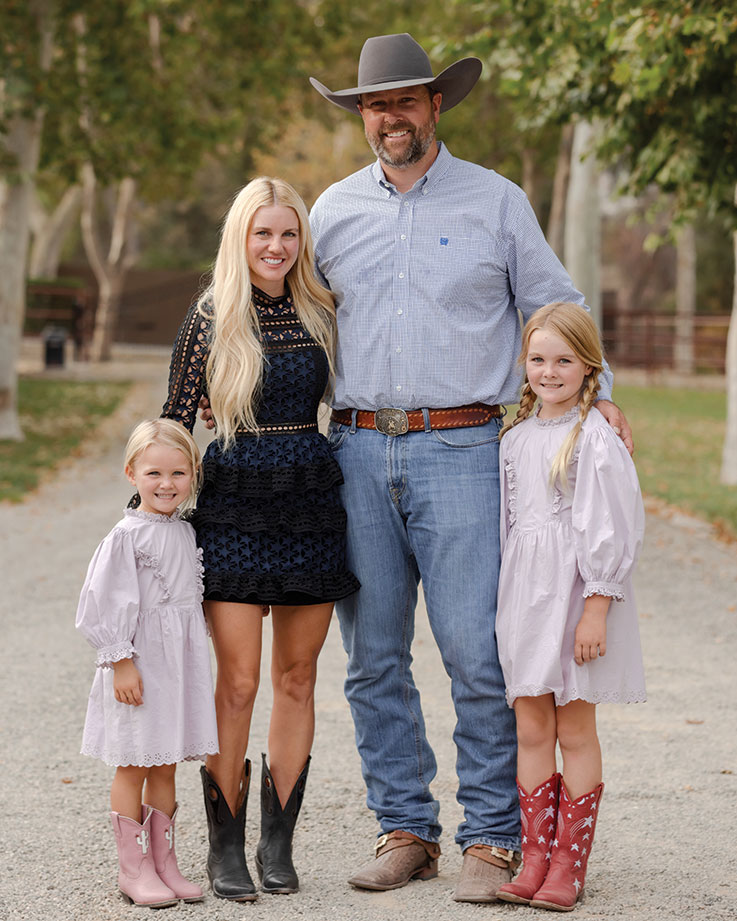
Dr. Troy Herthel studied at Cal Poly, San Luis Obispo, then went on to veterinary school at Oklahoma State University. In 2011, he made his way home to Los Olivos, CA, to work alongside his father at Alamo Pintado Equine Medical Center.
With time and experience behind him, Troy followed his heart back to Los Olivos in 2011. There was never a question as to where he belonged. “My dream was to come home and practice with my dad, learn from my dad and train under him,” affirms Troy. The pair reunited and had the opportunity to practice alongside one another and the team that had long since become family. Troy pursued a residency in equine surgery under the guidance of Dr. Carter Judy, an internationally-celebrated, board-certified equine surgeon at Alamo Pintado. There, they spent three years side-by-side with Troy gleaning all he could from Dr. Judy and the clinic’s talented team of surgeons. The elder Dr. Herthel was a proud and unwaveringly supportive dad. He was a fixture in the surgical suite, sometimes showing up unannounced after midnight, watching Troy’s talents evolve and offering wisdom and quiet counsel when asked but somehow never forcing his knowledge or style onto his son.
As in life, change happens and new chapters are written to beloved old stories. The elder Dr. Herthel was very suddenly taken by Lewy Body Dementia in 2018, followed closely by the passing of his wife Sue who, together with her husband, built Alamo Pintado Equine and brought its vision to life. They left behind a rich story of tremendous impact on the horses they cared for so deeply and with such fervor.
The comfort in such a profound loss was, of course, that Alamo Pintado Equine was right there, as strong as it ever was, being led on by a steady team, including the since board-certified surgeon, Dr. Troy Herthel. The clinic was firm in its future mission; it would honor the great Dr. Doug Herthel’s legacy by continuing to challenge the impossible using the most advanced diagnostic tools, imaging modalities, therapeutic nutrition and technology it could bring together.
Dr. Doug Herthel’s presence is still very much felt within these walls. He lives on in the team of veterinarians that worked so tirelessly beside him for so long and also in Dr. Troy Herthel. The two share many traits: a soft-spoken nature, a firm commitment to the horse and an unshakable dedication to how and why Alamo Pintado Equine practices veterinary medicine. “As a veterinarian and a surgeon, I’m just in awe all the time seeing what these animals can do and the bond between them and their rider,” says Troy.
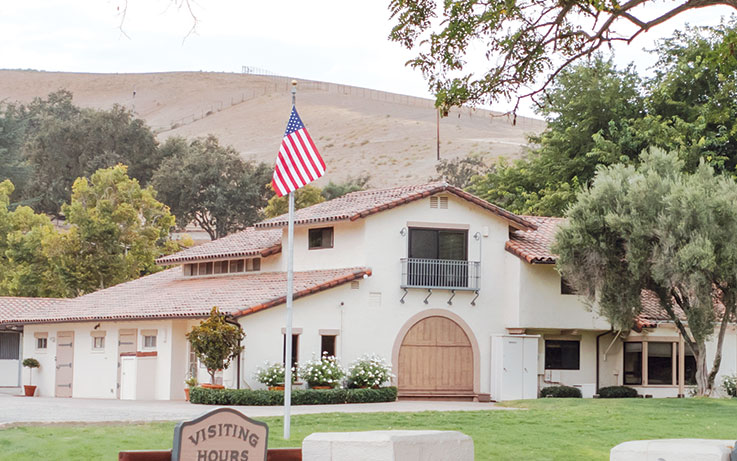
Alamo Pintado Equine Medical Center was founded in 1972 by the late Dr. Doug Herthel, a renowned veterinarian, surgeon and medical innovator, and his wife Sue. Over the past 50 years, the clinic has become a beacon of discovery and innovation in equine veterinary medicine. Their son, Dr. Troy Herthel, now carries on the family’s dedication to the horse together with a boldly-talented team of veterinarians.
Today, he scrubs up and heads into the surgical suite next to Dr. Wade Walker, a fellow board-certified surgeon who came to Alamo Pintado in 2019 to help further evolve the clinic’s capabilities. Drs. Erin Byrne and Carolina Lopez will be waiting to take over post-operative care, likely walking the halls late into the night to ensure patients receive every possible advantage, as is their usual routine. Dr. Lisa Teske’s vet truck rolls past the gates en route to an emergency call, while Drs. Ed Hamer and Greg Parks have been across town at respective Thoroughbred farms checking mares since early morning. There’s a lameness exam happening out front where Dr. Tyler Stevenson flexes a towering bay gelding before observing as he sends him off for another jog. Dr. Judy sits behind a collection of screens, reading images in real time as a 17-hand Warmblood lays anesthetized in the high field (1.5 tesla) magnetic resonance imaging, or MRI, machine. He studies images while discussing the case. This horse is a star in the hunter ring who carries numerous kids to the ribbons they’ve worked so hard for. You can hear the determination in his voice and almost sense the cogs turning. This horse is in the best of hands. Meanwhile, the newest member of the team, veterinary fellow Dr. Mariah Kerr, is suturing a laceration in the treatment room as the now-retired Dr. Mark Rick climbs the stairs to his desk to continue work on Alamo Pintado’s latest research initiative. So is life at the clinic. Trailers come and go at a steady pace throughout the day, horses are jogged, wounds are treated and dressed, surgeries are performed, imaging is captured and beneath it all is a charge that’s electric and almost palpable.
As Dr. Troy Herthel walks out of surgery he heads straight for a barn on the far side of the property. It’s late afternoon and two small blonde-haired girls squeal as he comes into view. Just like that, the day’s cases fade and the doctor becomes “Dad.” The girls, Crosby and Piper, are here to ride Teddy, the rope horse that was supposed to be Troy’s mount but quickly transitioned to carrying much more precious cargo (in his opinion). Troy and wife Jacie — an Oklahoma native — have taken the fabric of his storied childhood and family legacy, and interwoven their own life, family and dreams into a new tapestry. This is sacred ground. This place represents so much to Troy, his own family and the veterinarians he practices beside every day. Ask them, and they’ll tell you that they don’t feel the weight of Dr. Doug Herthel’s legacy. It’s part of who they are; a common thread that points them in the same direction toward the evolution of veterinary medicine on behalf of the horse.
“The most important thing to us is the results. My parents started this practice with their bare hands and were able to bring on an incredible group of people. I'm still honored to work with them. This practice has grown but it all goes back to the core values of Dr. Doug and Sue Herthel. I hope they’re really proud of the fact that we’re continuing those values.”
— Troy Herthel, DVM, DACVS, Alamo Pintado Equine Medical Center
As the day winds down and the bustle of activity around the clinic starts to calm, there’s a peace to this place. The girls finish their ride and put Teddy in his stall for the night. They climb into the side-by-side and soon the sight of taillights set against an orange sky lights up the early evening. Tonight will likely bring a colic surgery or late-hour emergency case, then tomorrow it’ll start all over again with new cases, clients and opportunities to change both horse and human lives. For now, Dr. Troy Herthel can make the short drive home up the hill and around the bend overlooking all that his family has worked so hard to build over the last 50 years. The past brought Alamo Pintado Equine to greatness, and the future will carry it forward with impact, innovation and soul. “The most important thing to us is the results,” assures Troy. “My parents started this practice with their bare hands and were able to bring on an incredible group of people. I’m still honored to work with them. This practice has grown, but it all goes back to the core values of Dr. Doug and Sue Herthel. I hope they’re really proud of the fact that we’re continuing those values.”
There’s something amazing about this little town, the people here and the way that an equine hospital has become so very much a part of the community both here and beyond. These veterinarians and this place leave their stamp on anyone who passes through the gates. There’s a reassurance that settles in when that double set of iron slowly opens. No matter what’s wrong, these people will tackle it, and they’ll go about their daily work with the elder Dr. Herthel’s mantra in mind: Be better, serve better and challenge what’s possible.
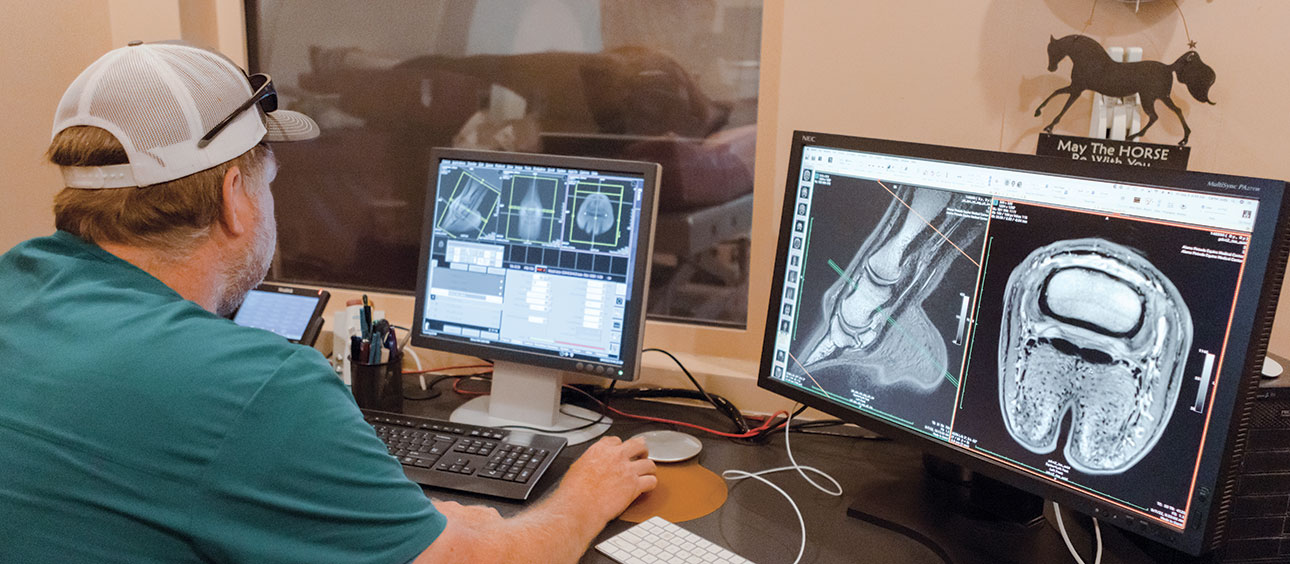
Dr. Carter Judy, a board-certified equine surgeon and world-wide authority in equine MRI examines real-time MRI images at Alamo Pintado Equine.
50 Years of Innovation at Alamo Pintado Equine
Many “Firsts” Have Taken Place at This World-Renowned Equine Hospital Over the Past Five Decades
In 1984, the clinic began what was the first veterinary internship program in the country, followed five years later by the first private nuclear scintigraphy machine — known casually as a “bone scan” — being installed.
In 1992, after hearing of an unfortunate outcome suffered by a mare with a just-repaired fracture, Dr. Doug Herthel designed and implemented a hydro pool, scissor-lift recovery system, allowing cases to come out of anesthesia submerged by sling in a warm-water pool, minimizing the risk of compromising their surgical results. In 1997, Alamo Pintado became the first private equine hospital to obtain a mobile Tomoscan CT. This advanced machine not only improved imagery of the head, neck and extremities, but also allowed enhanced intra-operative imaging capabilities.
Following that advancement, Dr. Herthel became known as the father of modern-day equine adult autologous bone marrow-derived mesenchymal stem cell therapy. Beginning with his novel approach to applying stem cells through injection of a bone marrow aspirate (BMA), Dr. Herthel worked for over 20 years to advance regenerative medicine in his never-ending quest to improve results in the horse. In 1996 as part of his biological approach to healing, Dr. Herthel brought his years-long pursuit of equine nutrition to the forefront with the founding of Platinum Performance®. As a tireless advocate for the preventive and therapeutic impact of advanced nutrition, Dr. Herthel worked to build nutrition from a previously-underappreciated component to equine wellness and high performance to now be known as a critical standard of care in equine veterinary medicine.
Rounding out his three-pronged “Biological Approach to Healing” that included regenerative therapy and advanced nutrition, the elder Dr. Herthel installed the first private equine hyperbaric oxygen chamber to provide patients with a climate-controlled environment with two atmospheres of pure oxygen. Alamo Pintado Equine has since installed the next iteration of hyperbaric chamber with a state-ofthe- art unit utilized for lessening the harmful effects of reperfusion injuries after crush wounds or intestinal injury, decreasing harmful bacterial loads and many more critical issues.
Following the 2006 completion of the MRI (magnetic resonance imaging) wing offering one of the only high-field Siemens Magnetom Espree MRI machines in the country, Alamo Pintado Equine continues to advance with today’s next generation diagnostic tools, including three-dimensional CT, PET scan (positron emission tomography) and a state-of-the-art Qualisys 12-camera motion detection and gait analysis system, the only one of its particular kind in the nation. “When my dad first started, he basically had a stethoscope and the thermometer; that’s about it,” says Dr. Troy Herthel, amazed at how far Alamo Pintado Equine and the industry have come.
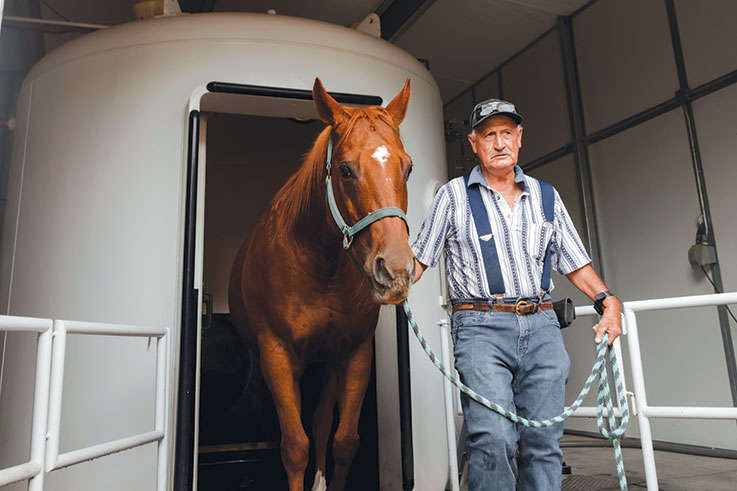
Alamo Pintado Equine’s state-of-the-art hyperbaric oxygen chamber.
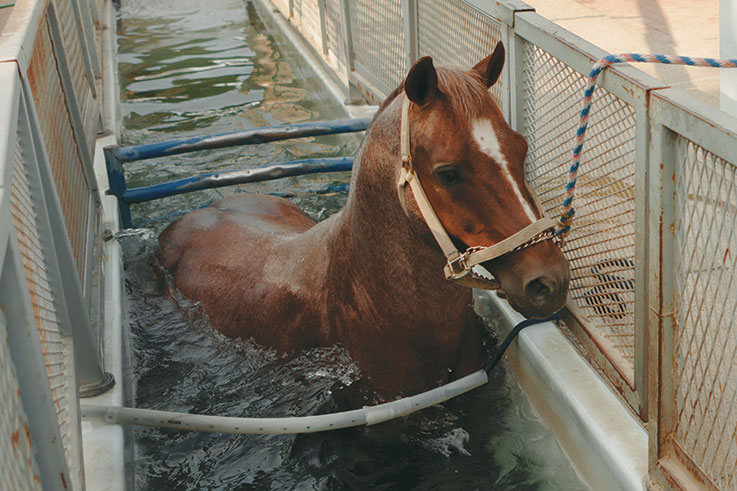
Patients are able to recover with the use of an underwater treadmill.
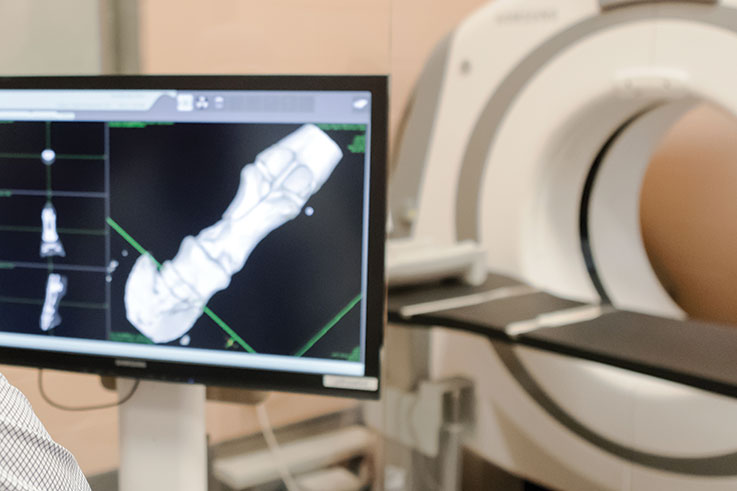
A mobile Tomoscan CT machine provides improved imagery of the head, neck and extremities.
